Abstract
Objective. To evaluate the efficacy and tolerance of a topical lip-care treatment. Step one of the two-step treatment is a lip-renewal formulation containing human growth factors, hyaluronic acid and marine filling spheres, emollients, and a tripeptide palmitoyl-glycyl-histidyl-lysine complex. Step two is a lip-plumper formulation containing niacin, emollients, and essential fatty acids. Design. Four-week, single-center, open-label, clinical study with clinical assessments at Baseline, Week 2, and Week 4. Treatment. Subjects wore the lip products at least eight hours every day with a minimum of three applications per day. Participants. Thirty-two women ages 22 to 40 years with mild-to-moderate lip dryness and average size lips completed the study. Measurements. Visual grading of the condition of the lips, rating of subjective irritation, corneometry, digital caliper measurements of lower lip, and digital photography. A self-assessment questionnaire was also employed to assess patient satisfaction. Results. Clinical assessments showed statistically significant improvements (P<0.001) in key lip condition parameters after both two and four weeks of use. Key parameters included lip scaling, cupping, cracking/fissuring, fine lines due to dryness, lip texture/visual roughness, lip color/rosiness, lip definition/contour, and overall lip condition. Significant increases (P<0.001) were observed in both corneometer measurements, which confirm the moisturizing benefits, and in digital caliper measurements, which confirm the lip-plumping benefits. Self-assessment questionnaires showed a 97-percent overall satisfaction rating. No adverse events were reported during the course of the study. Conclusion. The results from this clinical study demonstrate that this two-part lip-care treatment product was well tolerated and effective in restoring moisture and fullness to the lips of female subjects with mild-to-moderate lip dryness.
The lips are a central defining feature of the lower face as they are distinct from the surrounding skin. The appearance of the lips has a major effect on the aesthetic perception of the female face. Full and well-defined lips impart a sense of youth, health, and attractiveness.1 Similar to other features of the face affected by the aging process, aged lips become thin and flat and therefore appear less attractive.2 Products that effectively protect and enhance the lips are desirable aesthetic agents.
The lips form an extension from the mucosal membrane to the outer skin. Lips are covered by a thin layer of stratum corneum and have poor skin barrier function and low moisture capacity.3,4 Their red coloration is believed to result from a combination of decreased density of keratin and translucency of the tissue allowing the underlying capillaries to be observed.5
As a result of poor barrier function and low water-retaining capacity, the lips are highly susceptible to environmental effects, such as wind, sun, smoking, and temperature extremes. This environmental damage as well as certain medications can cause the lips to become dry, chapped, and dull in color. In addition to the environmental effects, there are age-related changes to the lips and perioral skin. Wrinkle number and visibility are linearly related to age, becoming more visible during the fifth decade.6 Histological analysis of the upper lip revealed that elastic and collagen fibers in the cutis undergo a degeneration process during the aging process with thinning of the cutis.7
A prominent sign of general skin aging is the development of fine lines and wrinkles caused by both intrinsic and environmentally induced aging processes.8 Intrinsic aging is a natural process relating to chronological age; whereas, environmentally induced aging results from external factors, the most notable of which is exposure to sunlight. The main structural changes resulting from both types of aging are characterized by a reduction in collagen and elastin, together with a loss in hydration.
Topical growth factors have emerged as novel anti-aging agents.9,10 These natural proteins have been shown in clinical studies to both decrease the appearance of wrinkles and to stimulate collagen synthesis.10—13
The lip care product used in this study is a two-step treatment. The step one lip-renewal formulation contains human growth factors, hyaluronic acid and marine filling spheres, emollients, and a tripeptide palmitoyl-glycyl-histidyl-lysine (Pal-GHK) complex. The step two lip-plumper formulation contains niacin, emollients, and essential fatty acids. This combination was designed to improve lip texture and condition and to increase lip fullness and volume providing a more youthful appearance.
The purpose of this four-week, open-label, single-center study was to evaluate the efficacy and tolerance of this novel combination lip system to condition, moisturize, and enhance lip volume and definition.
Methods
Study population. The criteria for study participation included healthy women aged 22 to 40 years, with Fitzpatrick skin types I to IV, having both mild-to-moderate dryness of the lower lip as determined by a clinical grader and self-perceived and clinically determined average size lips. Eligible subjects were regular users of lip products (clear or colored) at least four times a week. Subjects must have been willing to wear the test products for at least eight hours per day, every day, for the duration of the study, with a minimum application of three times a day.
Subjects could not have a history of lip injections or lip surgery or chronically dry or chapped lip conditions that are not improved with the use of lip-conditioning products. Subjects agreed not to apply any product (e.g., lipstick, lip gloss, lip conditioner) to the lips other than the test product for the duration of the study. Subjects discontinued use of all lip-enhancement products a minimum of three days prior to the baseline visit.
Written informed consent conforming to 21 CFR 50.25 was obtained from each subject prior to study enrollment.
Study design. During the four-week, open-label study, clinical evaluations were conducted at Baseline, Week 2, and Week 4.
Study endpoints. Efficacy. Visual assessment of lip parameters (scaling, cupping, cracking/fissuring) were graded on a scale of 0 to 6 at each clinic visit. Assessment of fine lip lines due to dryness, overall condition, lip color/rosiness, lip definition/contour, and lip texture/visual roughness were graded on a 10cm analog scale (with half points allowed) at each clinic visit. Corneometer CM 825 (Courage + Khazaka, Germany) measurements to quantify moisture content of the stratum corneum were taken (duplicate) with one measurement taken on each side of the lower lip at each clinic visit. A digital caliper measurement (duplicate) was used to evaluate plumpness of the lower lip at each clinic visit. Digital (Nikon D-100 camera) macrographs were taken of the lips in a relaxed, closed position at Baseline and Week 4. Subjects completed a self-assessment questionnaire immediately after initial application and at Weeks 2 and 4 regarding the test products.
Safety. Tolerance was assessed by objective and subjective irritation parameters and the reporting of adverse events. Objective irritation (erythema, edema) and subjective irritation (burning, stinging, itching, tightness, and tingling) were graded on a scale of 0 to 3 (with half points allowed) at each visit.
Subject self-assessment. Subjects completed a self-assessment questionnaire asking them to rate their experience using the lip products within minutes of initial application and at Weeks 2 and 4. Self-assessment questionnaires were tabulated and a top-box analysis was performed.
Statistical analysis. Clinical grading and instrumentation scores at each visit were statistically compared to baseline scores using a paired t-test. Changes from Baseline were considered significant at the p<0.05 level.
Results
Demographics. Thirty-two of the 42 female subjects who were enrolled completed the four-week study. Nine subjects were disqualified at Baseline; seven subjects because their lips were too full and two subjects because their lips were not dry enough. One subject voluntarily withdrew during the study. Subjects were primarily Caucasian (81%) and Hispanic (12%) and were aged 22 to 40 years.
Efficacy. Clinical assessments demonstrated statistically significant improvements (P<0.001) in all lip-condition parameters after two weeks and four weeks of use. These parameters included the following: scaling, cupping, cracking/fissuring, fine lines due to dryness, overall condition, color/rosiness, definition/contour, and texture/visual roughness. See Figures 1 to 3 for improvements over Baseline in these lip parameters after two weeks and four weeks of use. Figure 4 illustrates statistically significant increases (P<0.001) in corneometer measurements and in digital caliper measurements of the lower lip, which demonstrate moisturization and plumping benefits, respectively. Figure 5 shows digital photographs of subjects taken at Baseline and after four weeks of treatment. Results of the top-box analysis of the self-assessment questionnaires at the end of the study are shown in Table 1. Overall subject satisfaction with the lip-care treatment system at Week 4 was 97 percent.
Figure 1.
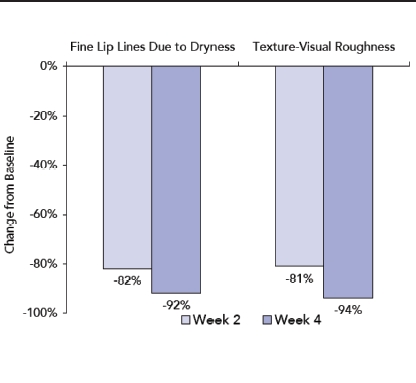
Mean reductions in fine lip lines and texture/roughness.
Figure 3.
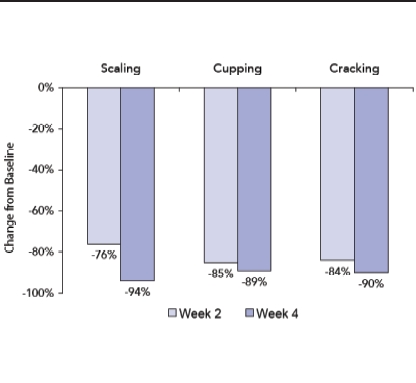
Mean improvements in parameters of lip dryness.
Figure 4.
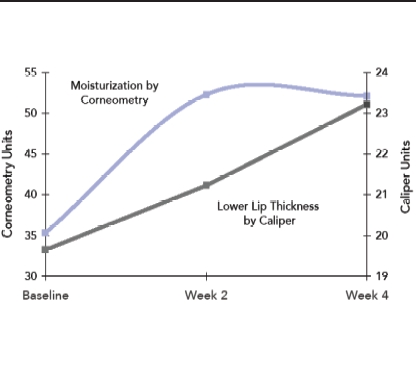
Mean improvements in moisturization and plumping of the lower lip
Figure 5.
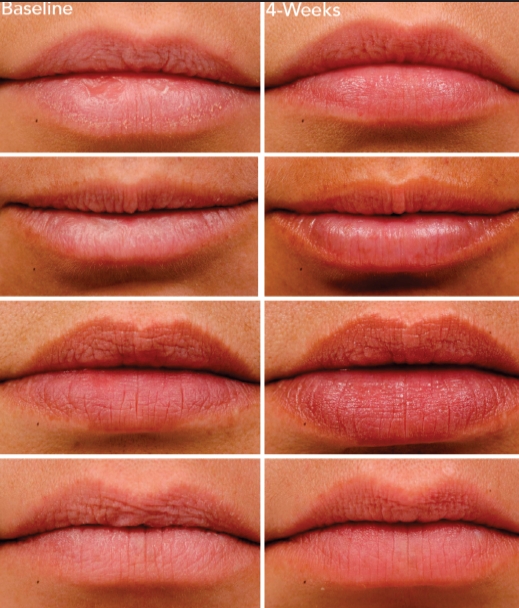
Photographs of subjects at Baseline and after four weeks of treatment.
Table 1.
Subject self-assessment of lip product attributes after four weeks treatment (% patients agree or strongly agree)
| PRODUCT ATTRIBUTES AT WEEK 4 | |
| Overall satisfaction (excellent or good) | 97% |
| Improved overall lip condition | 100% |
| Moisturized lips | 100% |
| Increased lip volume | 81% |
| Enhanced color | 91% |
| Improved lip outline/contour | 91% |
| Improved lip appearance | 97% |
| Softens fine lines around mouth | 78% |
| Lips look and feel healthier | 94% |
| Helped prevent lip dryness | 78% |
| Not oily or greasy | 81% |
| Is good for everyday use | 97% |
| Would use if available | 84% |
| Made lips feel smoother/softer | 94% |
Figure 2.
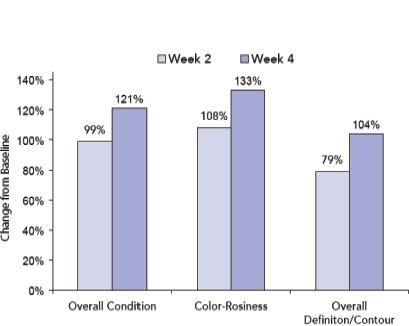
Mean improvements in condition of the lips.
Safety. The lip treatment system was well tolerated. No adverse events were reported during the course of the study. Only minimal increases in subjective irritation (burning and tingling) were observed.
Discussion
Right or wrong, physically attractive individuals reap many benefits in society across cultures. Studies have shown that facial attractiveness is assessed rapidly from small amounts of visual information.14 The appearance of the lips has a major effect on aesthetic impressions of an individual and on the overall attractiveness of the face.15,16 Traditionally, fuller lips have been considered more attractive than thin, flat lips. When lips are full and well defined, they evoke a sense of youth, health, and attractiveness. Thin, flat lips imply fragility and senility.1 Since ancient times, women have been highlighting their lips, and lipstick is a major component of the cosmetics industry. More recently, several aesthetic agents claiming to plump the lips have become available to consumers.
It has been shown that wrinkles or furrows in and around the vermilion border affect the color tone, spread, and pigment remnants of lipstick.17 As the depth and number of wrinkles are reduced, the lipstick make-up appearance assessed by image analysis improves significantly. Thus, an optimal lip product should include agents that both condition the lip skin to improve texture and reduce surface lines as well as increase lip fullness and definition and enhance the natural lip color.
In this clinical study, the two-step topical lip-care treatment showed statistically significant improvement in key lip condition parameters with continued improvement over the four-week study. Physician assessments of clinical efficacy demonstrated reductions of fine lip lines and visual roughness ranging from 81 to 94 percent at two and four weeks, respectively. Improvement rates in color, definition/contour, and overall condition ranged from 79 to 133 percent at two and four weeks, respectively. Physical measurements of the lips using corneometry to assess moisturization and calipers to assess lip fullness also demonstrated statistical improvements from Baseline. Since perception of the effectiveness of the treatment by the subject is critically important, a self-assessment questionnaire assessing product performance showed an overall satisfaction rating (excellent or good) of 97 percent.
Frequently, more invasive procedures, such as dermal filler injections, are chosen for the immediate and significant improvements they produce in the lips. However these procedures are also associated with certain disadvantages, such as a potential risk for complications and a period of recovery time.18 The two-step lip-care treatment, which produced significant improvements in all lip condition parameters including moisturization and plumping, provides a well-tolerated alternative to invasive procedures with no down time.
References
- 1.Etcoff N. Survival of the Prettiest: The Science of Beauty. New York: Doubleday; 1999. [Google Scholar]
- 2.Klein AW. In search of the perfect lip: 2005. Dermatol Surg. 2005;31:1599–1603. doi: 10.2310/6350.2005.31247. [DOI] [PubMed] [Google Scholar]
- 3.Ya-Xian Z, Suetake T, Tagami H. Number of cell layers of the stratum corneum in normal skin — relationship to the anatomical location on the body, age, sex and physical parameters. Arch Dermatol Res. 1999291:563–567. doi: 10.1007/s004030050453. [DOI] [PubMed] [Google Scholar]
- 4.Kobayashi H, Tagami H. Functional properties of the surface of the vermilion border of the lips are distinct from those of the facial skin. Br J Dermatol. 2004;150:563–567. doi: 10.1046/j.1365-2133.2003.05741.x. [DOI] [PubMed] [Google Scholar]
- 5.Zugerman C. The lips: anatomy and differential diagnosis. Cutis. 1986;38:116–120. [PubMed] [Google Scholar]
- 6.Leveque JL, Goubanova E. Influence of age on the lips and perioral skin. Dermatology. 2004;208:307–313. doi: 10.1159/000077838. [DOI] [PubMed] [Google Scholar]
- 7.Penna V, Stark GB, Eisenhardt SU, et al. The aging lip: a comparative histological analysis of age-related changes in the upper lip complex. Plast Reconstr Surg. 2009;124:624–628. doi: 10.1097/PRS.0b013e3181addc06. [DOI] [PubMed] [Google Scholar]
- 8.Uitto J. The role of elastin and collagen in cutaneous aging: intrinsic aging versus photoexposure. J Drugs Dermatol. 2008;7(2):S12–S16. [PubMed] [Google Scholar]
- 9.Mehta RC, Smith S, Grove GL, Ford RO, et al. Reduction in facial photodamage by a topical growth factor product. J Drugs Dermatol. 2008;7:864–871. [PubMed] [Google Scholar]
- 10.Mehta RC, Fitzpatrick RE. Endogenous growth factors as cosmeceuticals. Dermatol Ther. 2007;20:350–359. doi: 10.1111/j.1529-8019.2007.00149.x. [DOI] [PubMed] [Google Scholar]
- 11.Fitzpatrick RE, Rostan EF. Reversal of photodamage with topical growth factors: a pilot study. J Cosmet Laser Ther. 2003;5:25–34. doi: 10.1080/14764170310000817. [DOI] [PubMed] [Google Scholar]
- 12.Ehrlich M, Rao J, Pabby A, Goldman MP. Improvement in the appearance of wrinkles with topical transforming growth factor beta(1) and 1-ascorbic acid. Dermatol Surg. 2006;32:618–625. doi: 10.1111/j.1524-4725.2006.32132.x. [DOI] [PubMed] [Google Scholar]
- 13.Gold MH, Goldman MP, Biron J. Efficacy of novel skin cream containing mixture of human growth factors and cytokines for skin rejuvenation. J Drugs Dermatol. 2007;6:197–201. [PubMed] [Google Scholar]
- 14.Olson IR. Facial attractiveness is appraised in a glance. Emotion. 2005;5:498–502. doi: 10.1037/1528-3542.5.4.498. [DOI] [PubMed] [Google Scholar]
- 15.Fink B, Neave N. The biology of facial beauty. Int J Cosmet Sci. 2005;27:317–325. doi: 10.1111/j.1467-2494.2005.00286.x. [DOI] [PubMed] [Google Scholar]
- 16.Bisson M, Grobbelaar A. The esthetic properties of lips: a comparison of models and nonmodels. Angle Orthod. 2004;74:162–166. doi: 10.1043/0003-3219(2004)074<0162:TEPOLA>2.0.CO;2. [DOI] [PubMed] [Google Scholar]
- 17.Ryu JS, Park SG, Kwak TJ, et al. Improving lip wrinkles: lipstick-related image analysis. Skin Res Tech. 2005;11:157–164. doi: 10.1111/j.1600-0846.2005.00115.x. [DOI] [PubMed] [Google Scholar]
- 18.Hirsch RJ, Stier M. Complications of soft tissue augmentation. J Drugs Dermatol. 2008;7:841–845. [PubMed] [Google Scholar]


